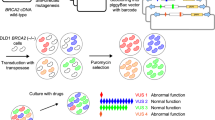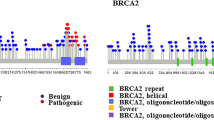Abstract
The majority of pathogenic mutations in BRCA1 result in a truncated protein. Although most missense changes in BRCA1 are of unknown functional significance, a handful of deleterious missense mutations have been identified. The majority of these occur in splice sites or highly conserved protein domains. Previously, we developed a predictive model, VUS Predict, to classify BRCA variants of uncertain significance as neutral or deleterious. It uses evolutionary prediction algorithms together with clinical information from cancer pathology reports and BRCA genetic testing results. Because of the higher probability that missense changes occurring in conserved BRCA1 domains are of pathogenic significance, we identified all individuals in our cohort who had been tested for BRCA1 and BRCA2 mutations who had missense changes in the BRCA1 ring finger domain and sought to classify those changes. We applied VUS Predict to three previously uncharacterized variants and four missense changes known to be deleterious. Two variants, L22S and T37K, were predicted to be deleterious and one variant, K45Q, was predicted to be neutral by VUS Predict. The mutations C39R, C44Y, C44S, and C61G were confirmed as deleterious.
Similar content being viewed by others
References
Easton DF, Deffenbaugh AM, Pruss D, Frye C, Wenstrup RJ, Allen-Brady K, Tavtigian SV, Monteiro AN, Iversen ES, Couch FJ, Goldgar DE (2007) A systematic genetic assessment of 1,433 sequence variants of unknown clinical significance in the BRCA1 and BRCA2 breast cancer-predisposition genes. Am J Hum Genet 81:873–883
Meza JE, Brzovic PS, King MC, Klevit RE (1999) Mapping the functional domains of BRCA1. J Biol Chem 274:5659–5665
Monteiro AN (2000) BRCA1: exploring the links to transcription. Trends Biochem Sci 25:469–474
Chenevix-Trench G, Healey S, Lakhani S, Waring P, Cummings M, Brinkworth R, Deffenbaugh AM, Burbidge LA, Pruss D, Judkins T, Scholl T, Bekessy A, Marsh A, Lovelock P, Wong M, Tesoriero A, Renard H, Southey M, Hopper JL, Yannoukakos K, Brown M, Easton D, Tavtigian SV, Goldgar D, Spurdle AB, kConFab Investigators (2006) Genetic and histopathologic evaluation of BRCA1 and BRCA2 DNA sequence variants of unknown clinical significance. Cancer Res 66:2019–2027
Tavtigian SV, Deffenbaugh AM, Yin L, Judkins T, Scholl T, Samollow PB, de Silva D, Zharkikh A, Thomas A (2006) Comprehensive statistical study of 452 BRCA1 missense substitutions with classification of eight recurrent substitutions as neutral. J Med Genet 43:295–305
Osorio A, Milne RL, Honrado E, Barroso A, Diez O, Salazar R, de la Hoya M, Vega A, Benítez J (2007) Classification of missense variants of unknown significance in BRCA1 based on clinical and tumor information. Hum Mutat 28:477–485
Spurdle AB, Lakhani SR, Healey S, Parry S, Da Silva LM, Brinkworth R, Hopper JL, Brown MA, Babikyan D, Chenevix-Trench G, Tavtigian SV, Goldgar DE, kConFab Investigators (2008) Clinical classification of BRCA1 and BRCA2 DNA sequence variants: the value of cytokeratin profiles and evolutionary analysis—a report from the kConFab Investigators. J Clin Oncol 26:1657–1663
Spearman AD, Sweet K, Zhou XP, McLennan J, Couch FJ, Toland AE (2008) Clinically applicable models to characterize BRCA1 and BRCA2 variants of uncertain significance. J Clin Oncol 26:5393–5400
Katagiri T, Kasumi F, Yoshimoto M, Nomizu T, Asaishi K, Abe R, Tsuchiya A, Sugano M, Takai S, Yoneda M, Fukutomi T, Nanba K, Makita M, Okazaki H, Hirata K, Okazaki M, Furutsuma Y, Morishita Y, Iino Y, Karino T, Ayabe H, Hara S, Kajiwara T, Houga S, Shimizu T, Toda M, Ymazaki Y, Uchida T, Kunitomo K, Sonoo H, Kurebayashi J, Shimotsuma K, Nakamura Y, Miki Y (1998) High proportion of missense mutations of the BRCA1 and BRCA2 genes in Japanese breast cancer families. J Hum Genet 43:42–48
Weitzel JN, Lagos VI, Cullinane CA, Gambol PJ, Culver JO, Blazer KR, Palomares MR, Lowstuter KJ, MacDonald DJ (2007) Limited family structure and BRCA gene mutation status in single cases of breast cancer. JAMA 297:2587–2595
Morris JR, Pangon L, Boutell C (2006) Genetic analysis of BRCA1 ubiquitin ligase activity and its relationship to breast cancer susceptibility. Hum Mol Genet 15:599–606
Honrado E, Benitez J, Palacios J (2006) Histopathology of BRCA1- and BRCA2-associated breast cancer. Crit Rev Oncol Hematol 59:27–39
Brzovic PS, Meza JE, King MC, Klevit RE (2001) BRCA1 RING domain cancer-predisposing mutations. J Biol Chem 276:41399–41406
Hashizume R, Fukuda M, Maeda I, Nishidawa H, Oyake D, Yabuki Y, Ogata H, Ohta T (2001) The RING heterodimer BRCA1-BARD1 is a ubiquitin ligase inactivated by a breast cancer-derived mutation. J Biol Chem 276:14537–14540
Ruffner H, Joazeiro CA, Hemmati D, Hunter T, Verma IM (2001) Cancer-predisposing mutations within the RING domain of BRCA1: loss of ubiquitin protein ligase activity and protection from radiation hypersensitivity. Proc Natl Acad Sci USA 98:5134–5139
Gomez Garcia EB, Oosterwijk JC, Timmermans M, van Asperen CJ, Hogervorst FBL, Hoogerbrugge N, Oldenburg R, Verhoef S, Dommering CJ, Ausems MGEM, van Os TAM, van der Hout AH, Lightenberg M, van den Ouweland A, van der Luijt RB, Wijnen JT, Gille JJP, Lindsey PJ, Devilee P, Blok MJ, Vreeswijk MPG (2009) A method to assess the clinical significance of unclassified variants in the BRCA1 and BRCA2 genes based on cancer family history. Breast Cancer Res 11:R8
Easton DF, Ford D, Bishop DT (1995) Breast and ovarian cancer incidence in BRCA1-mutation carriers. Am J Human Genet 56:265–271
Machackova E, Damborsky J, Valik D, Foretova L (2001) Novel germline BRCA1 and BRCA2 mutations in breast and breast/ovarian cancer families from the Czech Republic. Hum Mut 18:545
Couch FJ, Rasmussen LJ, Hofstra R, Monteiro AN, Greenblatt MS, de Wind N (2008) Assessment of functional effects of unclassified genetic variants. Hum Mutat 29:1314–1326
Acknowledgments
Funding for this study was provided by the Ohio State University Comprehensive Cancer Center. We thank the OSU Clinical Cancer Genetics Program for ascertainment of patients to this study. Caroline Craven and Molly Means were instrumental in obtaining patient medical records and clinical information. We thank Andrew Spearman for his work in developing the prediction model used for this study.
Author information
Authors and Affiliations
Corresponding author
Rights and permissions
About this article
Cite this article
Sweet, K., Senter, L., Pilarski, R. et al. Characterization of BRCA1 ring finger variants of uncertain significance. Breast Cancer Res Treat 119, 737–743 (2010). https://doi.org/10.1007/s10549-009-0438-6
Received:
Accepted:
Published:
Issue Date:
DOI: https://doi.org/10.1007/s10549-009-0438-6




